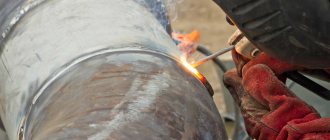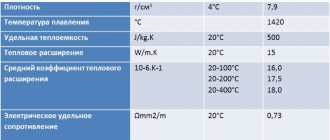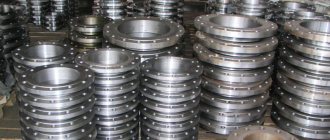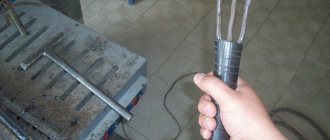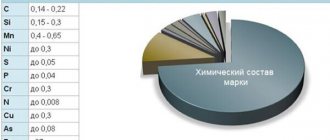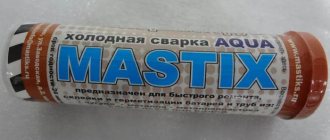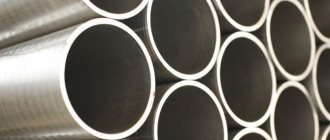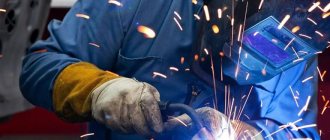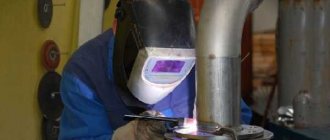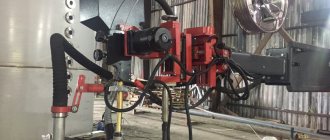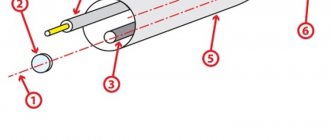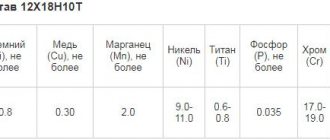Stainless steel electrodes - what are their features?
Welding stainless steel parts is a rather complex process. Carrying out the work requires the contractor to have the appropriate experience, knowledge and skills. To prevent filling of the weld pool with nitrogen, the minimum arc length should be maintained. In addition, corrosion-resistant steels have poor weldability , which greatly complicates joining. The reasons for this are as follows:
- The thermal conductivity of stainless steel is two times less than that of conventional carbon steel alloys. This leads to overheating of the products, so this technological process must be carried out at a lower welding voltage.
- When welding massive elements, you need to leave a fairly wide gap . Failure to comply with this requirement may lead to the formation of microcracks, reducing the quality and reliability of the seam.
- strong electrical resistance in the working area , which leads to heating of the electrode rod.
That is why, and also because of the above-mentioned features of welding, it is necessary to use special welding electrodes for stainless steel. An incorrect choice of welding materials can lead to intergranular corrosion, a dangerous type of destruction. This phenomenon causes a significant decrease in the reliability of the weld.
Welding methods
Technologies in which the use of welding electrodes for stainless steel structures is acceptable:
- pulse-arc for welding structural elements less than 0.1 mm thick, requires the use of welding electrodes with a certain coating composition;
- short-arc for welding structures whose thickness is less than 3 mm;
- plasma - a universal method that allows you to weld stainless steel of any composition;
- jet arc - used for connecting large parts with a supply of melting wire.
The welder must independently select electrodes depending on the thickness of the workpieces being joined, their composition, as well as the operating characteristics of the welded structures.
Welding recommendations:
- if you overheat the metal above +500 0C, then the likelihood of crystallization cracks increases;
- when the stainless steel is heated in the range of +350 0C - +500 0C, the part becomes embrittled, which can lead to a loss of strength properties;
- obtaining a high-quality weld is guaranteed when the workpiece is heated to +1200 0C followed by cooling for 180 minutes;
- prolonged heating of stainless steel is not recommended, as it partially loses its properties;
- when layer-by-layer welding it is necessary to bring each previous layer to +100 0C;
- To set two structural elements, you need to reduce the gap between them.
Stainless steel welding is in most cases carried out in a protective gas atmosphere. When choosing the composition of an electrode coating, it is necessary to take into account its thickness, strength, and properties.
When forming a seam, there is no need to sharply move the electrode along the surface. Usually, as a result of improper actions, deformations, cracks or other defects can occur inside it, as well as oxides can form.
It is important to adhere to the following rules:
- penetration of tungsten or compounds based on it into the weld pool is unacceptable; for this, the arc is ignited separately;
- The seam should be protected with a jet of argon.
AC or DC
Welding with alternating and direct current has its own special characteristics.
The main advantages of constant voltage : savings in welding materials due to low spatter levels; comfort and ease of work; high-quality seam; high welding performance; absence of unverified areas. The disadvantage is the high cost of equipment capable of delivering direct current. Read more here.
The main advantages of alternating current : lightness and affordable price of equipment operating on alternating current; ease of welding; guarantee of quality connection. Main disadvantages: less arc stability; A large amount of splashes leads to significant consumption of materials. Details here.
Corrosion-resistant steels can be welded in a variety of ways. However, most often, two joining methods are used for welding stainless steel:
- Manual welding with coated electrodes.
- Welding with a tungsten electrode in a shielding gas environment.
Depending on the welding method, different types of voltage are used, and accordingly electrodes suitable for alternating or direct current are used. [ads-pc-2][ads-mob-2]
DC electrodes on stainless steel
When starting work, the master must decide which electrodes can be used to cook stainless steel. Coated welding consumables ensure optimal joint quality without any problems. Manual welding is usually carried out using a constant voltage of reverse polarity. Therefore, the following grades of stainless electrodes are used:
TsL-11 is one of the most popular brands among welders; used for working with steels with high chromium and nickel content . A weld deposited using these consumables has several advantages: strength; plastic; accuracy; sufficiently high level of impact strength; no splashing.
OZL-8 electrodes are intended for welding structures that will be operated at high temperatures - up to 1000°C. At the same time, the advantages of this brand are in many ways similar to TsL-11.
NZh-13 is successfully used for welding parts made of food steel . Consumables of this brand are excellent at welding alloys containing chromium, nickel and molybdenum. The main distinctive feature of such electrodes is the formation of a thin layer of slag crust, which separates spontaneously.
Electrodes NII-48G.
Below is a list of several more popular electrodes for stainless steels:
ZIO-8 are intended for heat-resistant, corrosion-resistant steels.
NII-48G electrodes are used to work with critical structures.
OZL-17U are suitable for stainless steel operating in environments where sulfuric or phosphoric acids are present .
The corresponding section presents other brands of electrodes for stainless steel welding.
AC electrodes for stainless steel
Not all performers have equipment that operates at constant voltage. Which begs the question: is it possible to cook stainless steel with alternating current ?
There are such electrodes, for example, these are the brands OZL-14, LEZ-8, TsT-50, EA-400, OZL-14A, N-48, ANV-36 and others.
Welding with tungsten electrodes (in the picture) in a gas environment can also be carried out with alternating current of straight polarity. This connection method is used in the following cases:
- welding of thin-walled products;
- increased requirements for the welding seam.
This information will help a performer of any level determine which electrodes for welding stainless steel with alternating current should be used when solving specific problems.
As a conclusion, it should be noted that electrodes for AC stainless steel are less in demand. This fact is due to the less popularity of alternating voltage compared to constant voltage.
Permanent has a wide range of advantages and is used by professionals much more often.
[ads-pc-2][ads-mob-2]
Features of the welding process
The choice of joining technology is significantly influenced by the thickness of the products. For example, parts with a thickness of 1.5-3 mm are welded with a short arc. Thicker workpieces are joined by electric welding with jet transfer of electrode material.
Work is performed with both direct and alternating current. Each method has its own characteristics.
For example, direct current prevents metal spattering, which reduces the consumption of electrode material. In addition, the productivity and quality characteristics of the seam are increased.
Marking of electrodes on stainless steel
The packaging of all welding materials, without exception, contains basic identification information. The marking of electrodes for stainless steel is also equipped with this information, including the following designations:
- type, brand, diameter and purpose of the electrode;
- coating thickness;
- polarity;
- voltage setting;
- alternating or direct current.
The importance of using specialized electrodes
It is important to use electrodes for stainless steel for the following reasons:
- at elevated temperatures, anti-corrosion properties are lost, and the composition of the coating allows them to be preserved;
- as a result of a small coefficient of expansion, internal stresses or deformations may occur inside the seams or in the structures being connected;
- Due to low thermal conductivity, it is difficult to heat the metal evenly.
The correct choice of temperature conditions completely determines how well the weld will meet the required technical characteristics. When heated, the steel is deformed and there is a high probability of intercrystalline corrosion. Special coating compositions can prevent such negative consequences.
Electrodes for stainless steels and ferrous metals
Of course, welding of these materials is possible. However, welding ferrous and stainless steel has its own difficulties. The main problem is the heterogeneity of these metals. To obtain a high-quality seam, three types of welding are used:
- welding with coated electrodes;
- connection with tungsten non-consumable consumables;
- In a protective gas environment, argon is most often used.
To carry out welding of the first type, the following electrodes are used for welding stainless steel with black steel :
Electrodes OZL-312.
EA-395/9 are designed to work with critical structures.
OZL-312 is suitable for joining steels with unknown composition and when high weld strength is required.
It is also possible to use the ANZHR-1 and ANZHR-2 grades for welding dissimilar steels.
However, it is best to connect stainless steel and ferrous metal using argon welding. In such cases, argon performs an important function - protecting the working area from excessive saturation with nitrogen, and, accordingly, from oxidation. To ensure a reliable weld, the rod should be held perpendicular to the surface.
Based on the above information, we can conclude that common welding materials are used for welding stainless steel with ferrous metal. Consumables of these brands can be purchased from many suppliers and manufacturers.
Tool
To carry out the work, it is necessary to prepare a welding machine, additional tools, consumables, and wire of a certain chemical composition. List of required devices and materials:
- Inverter welding machine.
- Stainless steel filler wire.
- Electrodes (the quantity depends on the size of the seam, the number of parts to be welded).
Separately, it is necessary to talk about the choice of electrodes. There are several main types of consumable metal rods with a special coating:
- OZL-25B - used for joining heat-resistant steels.
- NIAT-5 - used for welding austenitic materials.
- TsT-28 - used for welding nickel-based alloys.
- E50F - used for joining heat-resistant metals.
We must not forget about setting up the welding material. Principles for selecting modes:
- For a part thickness of 1 mm, direct current of up to 60 A is used (electrode 2 mm in diameter).
- With a workpiece thickness of 2 mm, an alternating current of up to 80 A is set (electrode 3 mm in diameter).
- With a part thickness of 4 mm, a direct current of up to 130 A (4 mm electrode) is used.
If the current is too high, the materials will be damaged.
Inverter with mask and electrodes
Electrodes for welding stainless steel 12Х18Н10Т
12Х18Н10Т is austenitic stainless steel. This type of stainless steel is the most common and is used in many industries: food, chemical and pharmaceutical. Quite often, welded devices and vessels, and pipes for pipelines are produced from this type of steel.
TsL-9 electrodes in a package.
The following provides information with which you can determine which electrodes to use to cook 12x18n10t stainless steel.
The brand in greatest demand is TsL-9. Welding can be carried out in all spatial positions.
OK 61.30 electrodes have several advantages: good seam formation; easy ignition; self-separation of slag.
Welding consumables NZH-13 are used in cases where high requirements for resistance to MCC are imposed on the deposited metal.
OZL-14 are consumables used when the weld metal is not subject to strict requirements against MKK.
Is it possible to cook steel with stainless steel electrodes?
Brands of electrodes for stainless steel are used not only for processing the corresponding steels. These welding materials can be used for welding ordinary black steel. However, this combination is not suitable for performing critical work. Corrosion may form in both the working and heat-affected zones. In addition, the appearance of the connection will not be at the highest level. If the master nevertheless decides to resort to such a solution, it is recommended to weld accurately and quickly.
Manual welding in argon environment
The cleanest way to join surfaces with a great appearance. The only method that uses uncoated stainless steel electrodes. It is used when the seam must meet the most stringent requirements, or in welding thin sheets of steel.
The technology of welding with tungsten tips allows us to produce very high-quality, reliable and aesthetic seams. It is also possible at home. The current must be used direct or alternating with straight polarity.
Welding stainless steel with a tungsten electrode.
Features of the technology are as follows:
- It is important that tungsten does not get into the molten steel, so the arc must be ignited without direct fire - in a non-contact way.
- There is a risk of weld oxidation. To minimize it, welding must be done very smoothly, without any oscillatory movements.
- After finishing welding, there is no need to turn off the argon supply for 15 seconds. In this case, the tungsten tip will be protected from oxidation, and this will significantly save consumables.
What electrodes should be used to cook 1 mm stainless steel?
Welding thin metal is a complex process not only for beginners, but also for experienced welders. This process has several difficulties:
- strong heating of the product can lead to burnout and hole formation;
- high heating temperatures can also lead to changes in the geometry of thin sheets;
- the short arc with which the connection is made goes out with a slight separation.
These problems can significantly complicate welding work. Therefore, in order to avoid such difficulties, it is very important to know what electrodes are needed for welding thin stainless steel.
OK 63.34 are intended for welding thin metal. The brand is also perfect for thick-walled products. The electrodes are characterized by improved slag separation.
OK 63.20 (in the picture) is especially in demand for connecting pipes and thin metal. The welding process occurs with short-term ignition and extinguishing of the arc.
[ads-pc-4][ads-mob-4]
Briefly about technology
The technological cycle of joining stainless elements has a lot of nuances, which are determined by the special parameters of the metal.
- Thin-walled parts are connected using argon arc welding to avoid burnouts.
- Electric arc welding differs in the length of the arc - it should be as short as possible. Fluctuations during work are unacceptable.
- If the thickness of the workpiece exceeds 5 mm, the connection is made in two passes.
The thermal conductivity of stainless steel is lower than that of other metals. To obtain a high-quality weld, it is necessary to use a current with high parameters.
When working with argon arc welding, avoid getting tungsten into the melt zone - this will lead to destruction of the joint structure . It is recommended to ignite the arc separately with sequential transfer to the contact zone.
Popular electrodes for stainless steel welding
The most popular and popular welding materials are grades of stainless electrodes produced by leading factories. Trusted manufacturers carefully monitor product quality, guarantee fulfillment of obligations and offer favorable conditions for cooperation. In addition, brands of electrodes for welding stainless steel from well-known brands are in constant high demand.
ESAB
The Swedish concern ESAB provides a wide selection of consumables. Stainless steel electrode brands are very popular among professional welders.
OK 61.35 are intended for critical structures and are often used for welding pipelines for various purposes.
OK 67.72 – synthetic electrodes used for joining stainless and dissimilar steels.
OK 67.45 – dual-use welding materials: joining stainless steels and surfacing metals with a limited level of weldability. The seam withstands high temperatures and friction very well.
Also worth mentioning is OK 63.30; OK 61.30; OK 63.20; OK 61.35 .
Video with explanations of the choice from the manufacturer.
TsL-11
As mentioned earlier, this brand of welding materials is one of the most popular. The weld deposited with TsL-11 consumables is distinguished by accuracy, ductility, strength and high impact strength.
Monolith
The original welding materials of this brand are characterized positively by many craftsmen. For stainless steel they have the TsL-11 grade. Main advantages :
- attractive seam appearance;
- easy ignition, both initial and repeated;
- arc stability;
- self-removal of slag crust;
- low splashing;
- possibility of welding on oxidized, painted and oily surfaces;
- It is also possible to carry out welding from household power sources;
- Monolith welding materials are suitable for making connections in hard-to-reach places.
SSSI
If you don’t have special electrodes for stainless steel on hand, you can weld with other brands. Most often, experts ask the question: is it possible to cook stainless steel? Looking at this question from a technical point of view, the answer is yes. UONI is suitable for working with corrosion-resistant steels. From a practical point of view, you should know what kind of electrode is needed for welding stainless steel.
UONI-13/NZh have several advantages: welding is possible in almost all positions; small amount of splashes.
UONI-13/NZH-2 are intended for corrosion-resistant acid-resistant steels.
UONI-13/EP-56 are used for welding stainless steels, working in aggressive steels, as well as for welding pipelines.
It should be noted that it is better to weld stainless steel with welding electrodes specially designed for this purpose.
Preparation
Inexperienced welders often neglect high-quality surface preparation, which they then pay for by repeating the work. For stainless steel, this involves thoroughly degreasing the contact area with acetone or another solvent .
When choosing equipment, you should remember that it is allowed to weld with an electric arc at a thickness of up to 3 mm, while for semi-automatic welding in a shielding gas environment there are no such restrictions.
Avoid sudden movements when working - this breaks the protective layer, which leads to the penetration of oxygen deep into the weld, activating corrosion processes.
Which electrodes are better for stainless steel?
It is very difficult to answer the question posed. Each welder gives preference to his own consumable and independently determines which electrodes can be used to weld stainless steel. Some brands stand out from the entire variety of brands presented. NERO, Monolit, SSSI are among the market leaders. Consumers characterize their products as follows: “good and high-quality electrodes.”
Video
We invite you to see for yourself a selection of rollers with different brands and their use on stainless steel.
Basic technologies and varieties
In addition to the basic requirements for electrodes, there are several methods that are most often used for welding sheet or other types of stainless steel. The quality of welding is influenced by many factors that affect the further use of the material and the possibility of processing by various methods. Therefore, everyone who plans to use stainless steel should know the main features of steel and its main differences from carbon steel.
Stainless steel can be welded using various methods, but the most popular and used for medium-density material remains gas welding. For this method, a tungsten electrode with minimal melting ability is used. This method can be used to weld stainless steel for various purposes. For example, creating a pipeline from steel or various parts where stainless steel is applicable.
Depending on the technical equipment and requirements, electrode welding can be performed using manual, automatic and semi-automatic methods.
Consumable electrodes can also be used. They are additionally coated with special substances or wire with a high degree of alloying is used. For this variety, separate welding methods are selected:
- Pulse-arc;
- Short-arc;
- Jet arc;
- Plasma
They all differ in certain properties. For example, the first option is used for thin surfaces - the calculation is per tenth of a millimeter. Arc, on the contrary, is used for medium sheets, up to three millimeters thick. Plasma, in turn, is a universal method of welding stainless steel.
Popular manufacturers
Almost all manufacturers offer customers a wide selection of electrodes for corrosion-resistant steels. The demand for stainless steel, and, accordingly, welding materials for it, requires this from factories. Among the leading manufacturers, the following concerns should be noted: Losinoostrovsky Electrode Plant, Spetselektrod (Moscow), Zelenograd Electrode Plant, Kirov Plant, ESAB, Lincoln Electric, Quattro Elementi.
This article provides a complete and clear answer to many questions that welders have when working with stainless steel products and structures. After reviewing the information presented, each performer will be able to decide which electrodes to use to weld stainless steel.
Classification of high alloy steels
Before moving on to the issue of choosing electrodes for welding stainless steel, it is necessary to define the very concept of this material. Popular terminology divides all steel into two main classes - the stainless steel in question and the so-called chernukha. The signs that distinguish stainless steel from chernukha, known to most, are:
- appearance - shiny stainless steel (although not always), without traces of scale and corrosion;
- viscosity and lower hardness, which is easily determined with a chisel, file, drill, hacksaw or abrasive wheel;
- A popular method is also testing with a magnet - stainless steel is not magnetic, which is also not always true.
The above knowledge is clearly not enough to perform such a critical connection as a welded one; it is also unacceptable to cover with one term a large group of steels classified by GOST as stainless steel.
The stainless steel class includes steels that have the ability to work in corrosive environments, and this ability is determined by the presence of alloying elements, mainly chromium and nickel.
The official document regulating the classification of stainless steels is the interstate standard GOST 5632–14. In accordance with its definitions, alloyed stainless steels include steels with a chromium content of at least 10.5% and a carbon content of not more than 1.2%; corrosion-resistant steels and alloys are those that are resistant to any type of corrosion (chemical, electrochemical, intergranular , stress corrosion and others).
Stainless alloy steel grades
The specific purpose and scope of steel is determined by its internal structure - chemical composition and type of crystal lattice, which in turn also depend on the method of melting, heat treatment, and rolling. Without delving into the theory of metallurgy, we present the division of alloyed stainless steels into structural classes in accordance with GOST 5632–14:
- martensitic;
- martensitic-ferritic;
- ferritic;
- austenitic-martensitic;
- austenitic-ferritic;
- austenitic.
The structure of steel largely determines its technological quality, such as weldability. The presence of chromium in high-alloy corrosion-resistant steels determines the characteristic concept of “intergranular corrosion”. When welding, granular structures of chromium carbide with reduced strength and a tendency to brittle fracture are formed at the boundary of heat-affected zones. This quality largely determines the special requirements for the welding technology of these steels and welding materials for its implementation.
Stainless steel marking
Joining the popular terminology - stainless steel - let's consider its designation in accordance with the requirements of GOST 5632-14. For stainless steel, the designation corresponds to the all-Russian steel designation system, inherited from the Soviet one. The first two digits indicate the carbon content in hundredths of a percent, then the alloying element and its content in percent are indicated sequentially by the letter of the Russian alphabet. If there are no numbers behind the letter, then the content of the element does not exceed 1 percent.
Without listing all the chemical elements, we present the designations of some characteristic of stainless steels: X - chromium, H - nickel, T - titanium, B - tungsten, M - molybdenum. Alloying elements can also be non-metals. In the designations of many steels according to GOST 5632-14 you can see the letters A - nitrogen, G - manganese, E - selenium.
As you can see, the designation of stainless steel carries information about its chemical composition, which mainly determines the chemical composition of the welding materials used.
